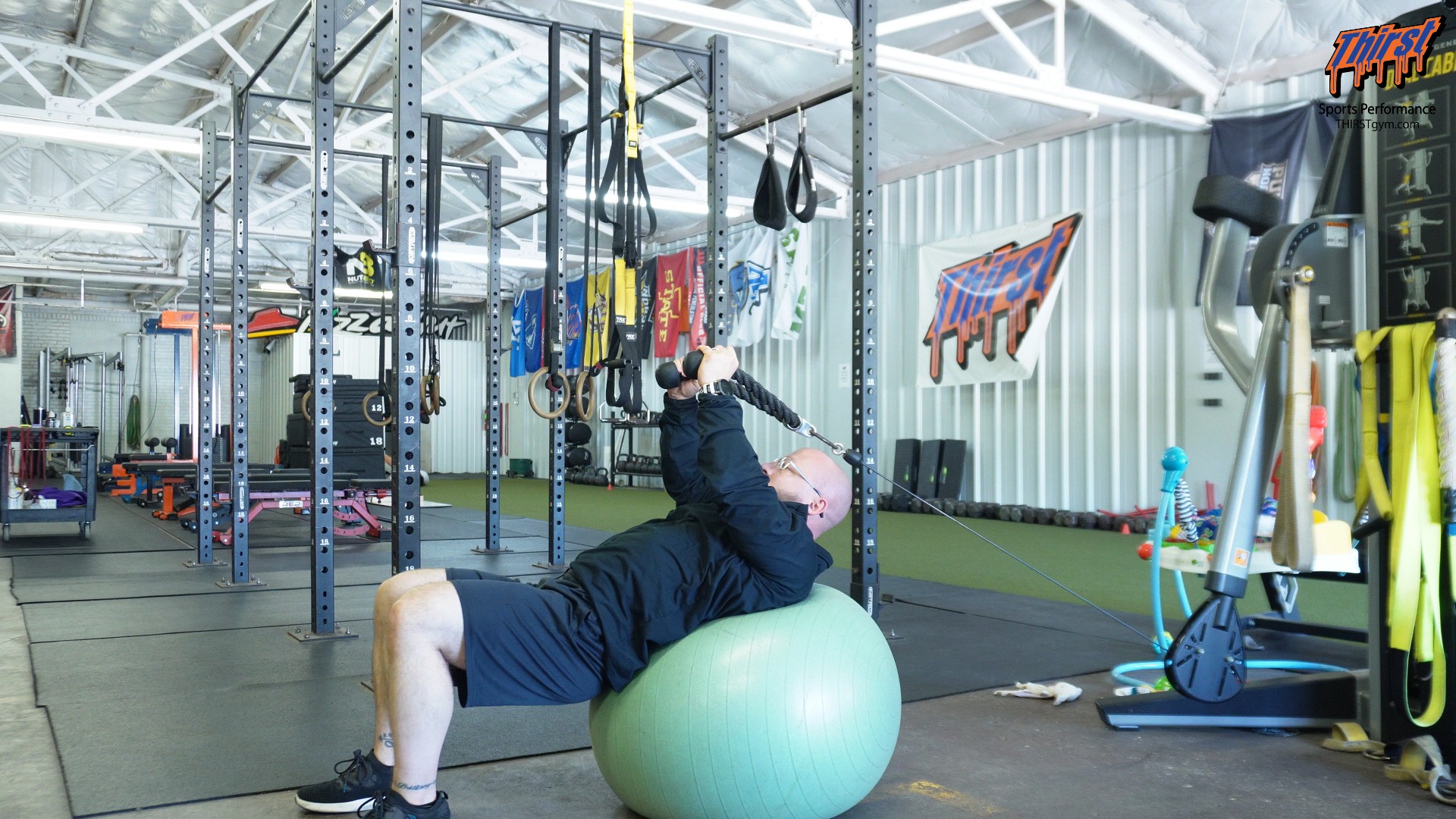Supine Stability Ball Cable Lat Pullover: A Full-Body Accessory Exercise for Back Development
The supine stability ball cable lat pullover represents an innovative approach to traditional lat training that transforms a simple back exercise into a comprehensive full-body movement. This exercise combines the deep lat stretch of conventional pullovers with the unique stability demands of working on an unstable surface, creating a training stimulus that extends far beyond basic back development. Whether you’re looking to build lat hypertrophy, improve thoracic mobility, or incorporate more integrative exercises into your strength training program, this cable machine variation offers a fresh perspective on accessory work.
Watch the video below on how to maximize this exercise.
Equipment Setup and Exercise Configuration
Setting up this exercise properly establishes the foundation for effective execution and safety. You’ll need access to a cable machine with adjustable height settings, a stability ball large enough to support your upper back comfortably, and ideally a rope attachment. The cable should be positioned at the lowest possible setting on the machine to create the proper pulling angle throughout the movement. While a straight bar attachment can work in a pinch, the rope attachment provides superior comfort and a more natural hand position during the pulling motion, allowing your wrists to remain in a neutral position throughout the entire range of motion.
Position your stability ball approximately three to four feet away from the cable machine, adjusting this distance based on your arm length and the specific setup of your equipment. The goal is to create enough tension on the cable even in the fully stretched position while maintaining proper body positioning on the ball.
Exercise Execution and Technique Breakdown
Begin by lying supine on the stability ball with your upper back and shoulders supported, similar to the starting position you would adopt for stability ball hip thrusts or chest presses. Your body should form a tabletop position with your knees bent at roughly ninety degrees and your feet planted firmly on the floor. Reach overhead to grasp the rope attachment with both hands, keeping your arms as straight as possible throughout the movement while maintaining a slight bend in the elbows to protect the joint.
The starting position places your body in significant thoracic extension, which is precisely what makes this exercise uniquely effective for lat development. Unlike unsupported thoracic extension, which can create excessive stress on the spine, the stability ball provides crucial support that allows you to safely access this extended position. This creates what can be described as a natural C-curve through your torso, maximizing the stretch on your latissimus dorsi muscles without compromising spinal integrity.
From this stretched position, initiate the pulling motion by driving your arms forward in an arc-like pattern, bringing the rope attachment from behind your head to approximately chest level. The movement should feel like you’re performing a traditional dumbbell pullover, except the cable provides constant tension throughout the entire range of motion. Stop the movement when your hands pass just beyond your chest, as bringing the cable any further would cause the attachment to contact your head or face.
Understanding the Full-Body Integration
What elevates this exercise beyond a simple lat isolation movement is the comprehensive muscular engagement required to maintain proper positioning. Your hamstrings play a critical role in this exercise, working isometrically to prevent the cable tension from pulling your body forward toward the machine. This constant hamstring engagement to anchor your pelvis and maintain stability transforms the movement into a posterior chain exercise that simultaneously trains your back and the backs of your legs.
Your abdominal muscles also receive significant stimulation throughout this movement. As you pull the cable forward, your core must work to control the eccentric stretch phase and maintain torso stability against the resistance. This abdominal engagement becomes particularly pronounced in the stretched position, where your abs experience a loaded stretch that can contribute to core strength development and control.
The stability ball itself introduces an additional balance component that forces constant micro-adjustments throughout your entire body. Your glutes, lower back stabilizers, and even your feet must work continuously to maintain your position on the unstable surface, creating a neuromuscular training effect that extends well beyond what traditional lat exercises provide.
Programming Recommendations and Training Applications
This exercise functions best as an accessory movement toward the end of your training session, after you’ve completed your primary compound movements. The combination of balance demands, extensive range of motion, and full-body engagement makes it less suitable as a primary back builder but excellent as a finishing movement that accumulates training volume while providing unique training benefits.
Aim for repetition ranges between ten and twenty reps per set, focusing on controlled movement quality rather than maximal loading. The extended range of motion and balance requirements make this exercise particularly effective with moderate weights that allow you to maintain proper form throughout the entire set. Plan for two to four sets depending on your overall training volume, recovery capacity, and how this exercise fits within your broader program structure.
This exercise works particularly well on full-body training days where you want to address multiple muscle groups efficiently, or as part of back and hamstring focused training sessions. The unique combination of lat stretching, hamstring isometric work, and core engagement makes it an excellent choice when training time is limited but you still want comprehensive muscle stimulation.
The supine stability ball cable lat pullover demonstrates how thoughtful exercise selection can transform traditional movements into more complete training tools. By combining the hypertrophy-inducing lat stretch of pullovers with the stability demands of ball training and the constant tension of cable resistance, this exercise delivers multiple training benefits within a single movement pattern.








